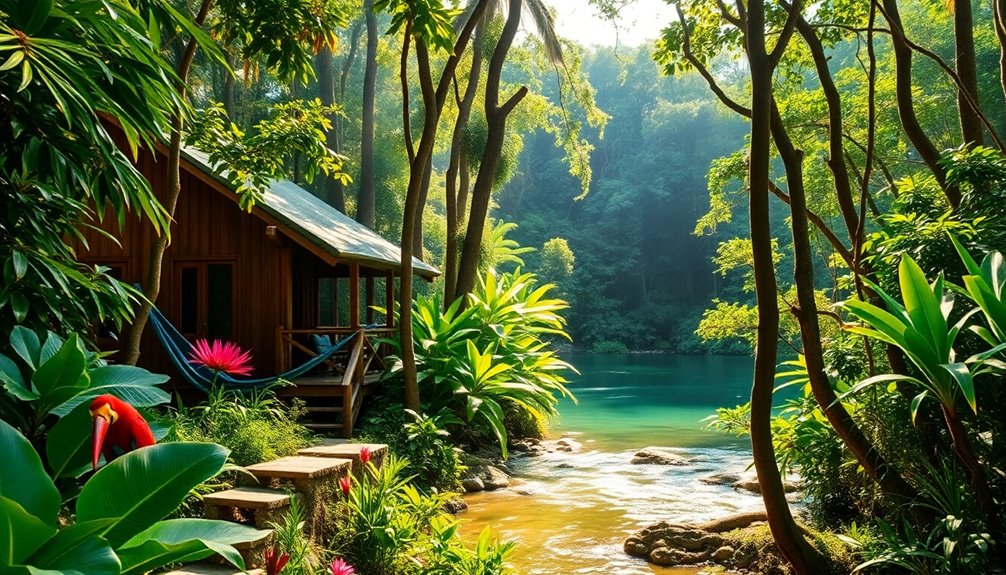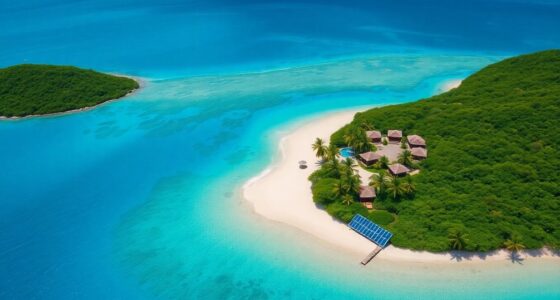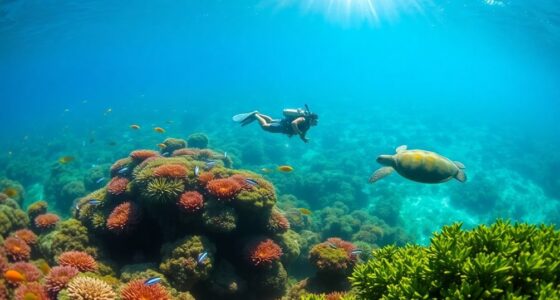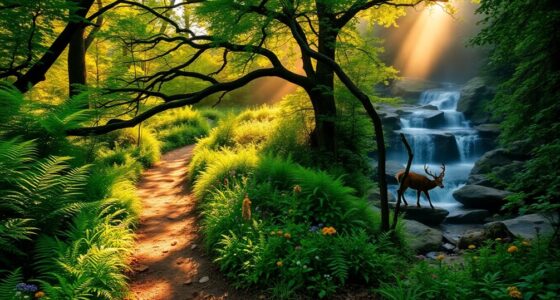Ecuador's eco-lodges let you explore the heart of the Amazon while supporting conservation and local communities. You'll find luxurious accommodations surrounded by stunning wildlife, including over 600 bird species and unique monkeys. Engage in adventure activities like guided jungle walks and canoeing, where expert guides share their ecological insights. These lodges focus on sustainability, using biodegradable products and supporting community-led projects. Travel logistics are smooth, with easy access from Quito. When you choose eco-lodges, you're not just enjoying nature; you're making a positive impact. Keep exploring to discover even more about this incredible experience!
Key Takeaways
- Ecuador's eco-lodges, like Napo Wildlife Center, offer luxurious accommodations amidst the Amazon's rich biodiversity and unique wildlife experiences.
- These lodges support local communities by directing ecotourism revenue to Indigenous groups and promoting sustainable environmental practices.
- Adventure activities include guided jungle walks, canoeing, and tailored birdwatching tours, enhancing ecological insights and wildlife photography opportunities.
- Travelers can easily access eco-lodges via short domestic flights and scenic canoe rides through the lush Amazon waterways.
- The best wildlife viewing occurs during the low-water season (June to November), offering enhanced visibility and intimate experiences with nature.
Introduction
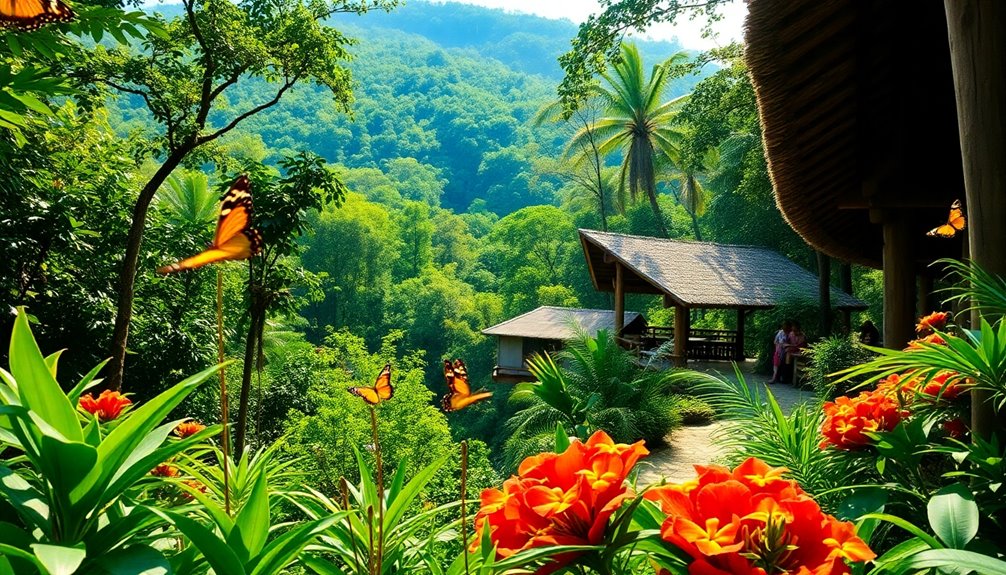
When you think of Ecuador, imagine stepping into a biodiversity hotspot brimming with life and adventure.
Eco-lodges here offer a chance to experience the Amazon's unique ecosystems while actively contributing to their preservation.
You'll find yourself surrounded by stunning landscapes and vibrant wildlife, all while enjoying sustainable luxury.
Biodiversity Hotspot and Adventure
Nestled in the heart of Ecuador, the Amazon rainforest beckons adventurers and nature lovers alike, showcasing one of the planet's richest biodiversity hotspots. Here, you'll encounter over 600 bird species, eight species of monkeys, and more than 50 species of bats, all thriving in their natural habitat.
Yasuní National Park, a critical part of this hotspot, invites you to immerse yourself in pristine nature while observing unique wildlife. Staying at an eco lodge like the Napo Wildlife Center enhances your experience, offering luxurious accommodations that connect you to the rainforest.
Engage in adventure activities such as guided jungle walks, canoeing, and birdwatching excursions, all led by expert guides who enrich your exploration of this incredible ecosystem.
Preserve Amazon's Unique Ecosystems
Ecuador's Amazon is a treasure trove of biodiversity, and preserving its unique ecosystems is vital for maintaining the planet's health.
You can play a part in this vital conservation effort by choosing eco-lodges that prioritize sustainable practices. Here are three ways these eco-lodges contribute to preserving the Amazon:
- Supporting Local Communities: Eco-lodges like Kapawi channel 100% of ecotourism revenue back to the Achuar Indigenous community, fostering cultural preservation and rainforest protection.
- Educational Programs: Many lodges offer educational initiatives that enlighten visitors about rainforest ecology and the importance of biodiversity.
- Promoting Responsible Tourism: By encouraging sustainable practices, eco-lodges help combat deforestation and wildlife exploitation, ensuring the Amazon thrives for future generations.
Travel From Quito to Lodge
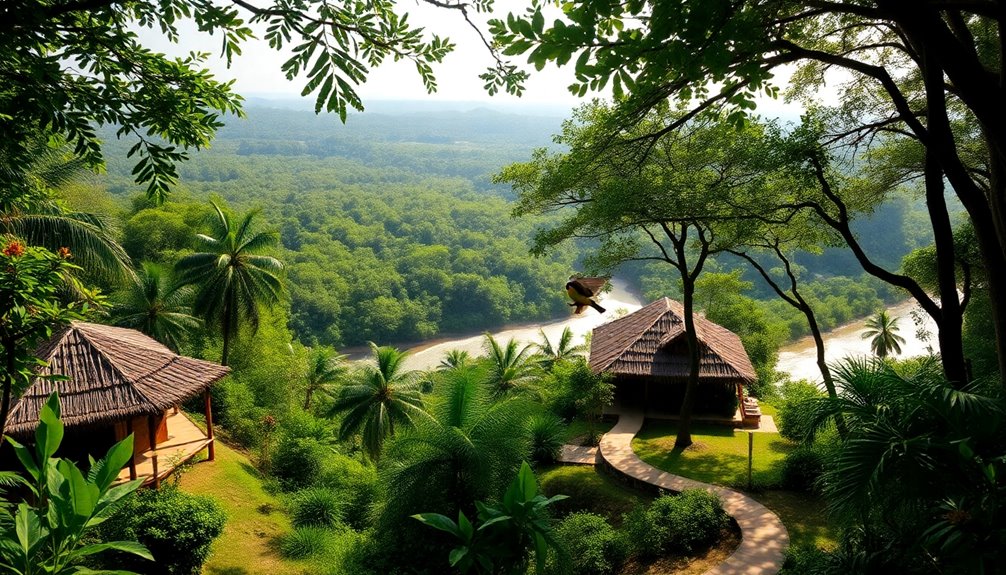
To reach your eco-lodge in the Amazon, you'll first fly into Quito from various international destinations like the USA, London, or Sydney.
After landing, you'll take a short flight to a nearby airstrip, followed by an exciting canoe ride through the jungle.
Make sure to check the specific travel arrangements for your lodge to ensure a smooth journey.
Fly From the USA to Quito
How do you get from the USA to the enchanting eco-lodges of Ecuador? It's simple! You'll start by flying from major U.S. cities like Miami or Houston to Quito. The direct flight takes about 5 to 6 hours.
Once you land in Quito, follow these steps:
- Take a 25-minute domestic flight to a local airport near the Amazon, like Francisco de Orellana (Coca).
- Enjoy a scenic two-hour motorized canoe ride, immersing yourself in the lush surroundings of the Ecuadorian Amazon.
- Listen for the calls of tamarind monkeys as you approach your eco-lodge destination.
In total, expect the journey from Quito to the lodge to take about 3 to 4 hours, depending on schedules and weather.
Fly From London to Quito
Traveling from London to Quito is your gateway to the stunning eco-lodges nestled in the Amazon. The journey typically takes around 10-12 hours, with various connecting flight options available. Once you arrive in Quito, you can easily reach your lodge with a quick 25-minute flight followed by a two-hour motorized canoe ride, immersing you in the heart of the Amazon rainforest.
| Step | Duration |
|---|---|
| Flight to Quito | 10-12 hours |
| Flight to Lodge | 25 minutes |
| Canoe Ride | 2 hours |
| Sounds of Nature | Instant upon arrival |
Many eco-lodges, like Sacha Lodge and Kapawi Eco-Lodge, offer organized transfers, making your travel seamless. Be sure to plan for potential layovers!
Fly From Sydney to Quito
While flying from Sydney to Quito may seem like a long journey, the excitement of reaching the Amazon's eco-lodges makes it worthwhile.
After your flight lands in Quito, you'll take a quick 25-minute flight to the Amazon region. This leg of the trip offers stunning aerial views of the Andes before descending into the lush rainforest.
Once you arrive, enjoy a scenic two-hour motorized canoe ride to your eco-lodge, where the adventure truly begins.
Here are three highlights of your journey:
- Immerse yourself in the sounds of the Amazon rainforest.
- Explore extensive ecological reserves surrounding the lodges.
- Participate in guided tours that enhance your connection to nature.
Get ready for an unforgettable experience!
Jungle Boat and Canoe Rentals
After arriving at your eco-lodge in the heart of the Amazon, you'll find an array of jungle boat and canoe rentals available to enhance your adventure. A short flight from Quito followed by a scenic two-hour motorized canoe ride sets the stage for your exploration.
Once settled in, you can choose from canoe rentals to navigate the waterways at your own pace, immersing yourself in the lush surroundings and vibrant wildlife. Listen for the calls of tamarind monkeys and observe the rich biodiversity as you paddle along.
Many lodges also offer guided canoe tours, ensuring you make the most of your experience while providing safety equipment and knowledgeable guides to enhance your journey through this stunning ecosystem.
Wildlife Photography Expeditions
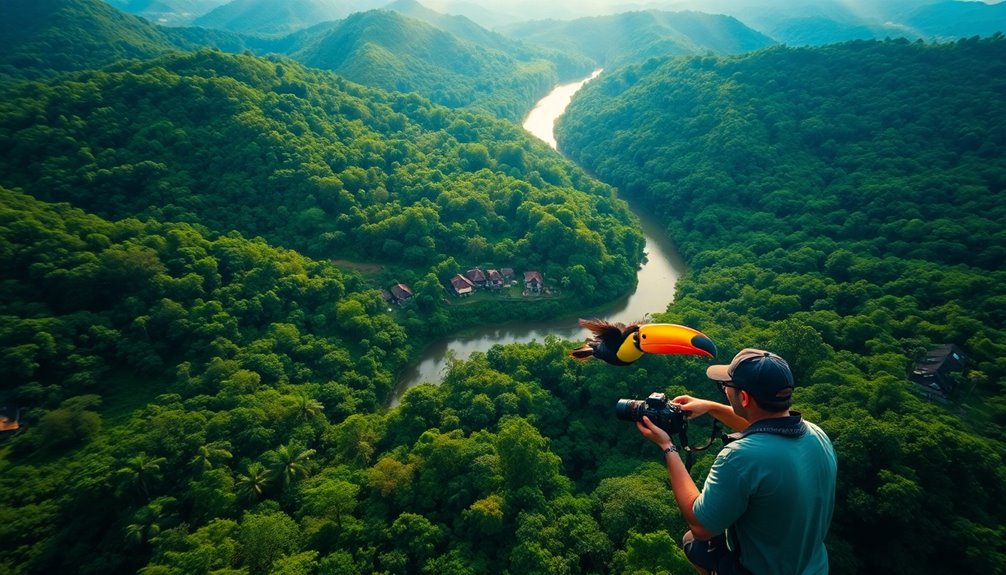
If you're passionate about wildlife photography, Ecuador's eco-lodges offer amazing opportunities for conservation-focused tours.
You can participate in sustainable observation excursions that respect the delicate ecosystems while capturing breathtaking images.
With options for jungle lodging that prioritize sustainability, your photographic journey aligns perfectly with eco-friendly practices.
Wildlife Conservation Photography Tours
There's something truly special about embarking on wildlife conservation photography tours in Ecuador's Amazon.
You'll get the chance to capture stunning images of unique wildlife, from over 600 bird species to eight types of monkeys, all set against breathtaking landscapes.
These tours often emphasize conservation, with proceeds supporting local indigenous communities and environmental initiatives.
Here are three highlights of your experience:
- Expert Guidance: Learn from knowledgeable guides who share insights on wildlife behavior and conservation efforts.
- Prime Locations: Visit macaw clay licks and canopy towers for incredible wildlife observations.
- Social Impact: Share your photos on social media, raising awareness about the Amazon's beauty and fragility.
Join these tours to hone your photography skills while contributing to vital conservation efforts! Additionally, these adventures often involve regular maintenance of camera gear to ensure optimal performance during your expeditions.
Sustainable Wildlife Observation Tours
As you venture into Ecuador's Amazon, sustainable wildlife observation tours offer an unforgettable opportunity to explore diverse ecosystems while minimizing your environmental impact.
These tours prioritize eco-friendly practices, allowing you to experience the rich biodiversity of unique habitats like Yasuní National Park. With over 600 bird species and various monkeys, it's a paradise for wildlife photography enthusiasts.
Expert guides enhance your experience, helping you capture stunning moments while respecting local wildlife. Many eco-lodges, such as the Napo Wildlife Center, provide specialized birding tours and guided treks tailored for photographers. Additionally, these eco-lodges often utilize heat pump technology to maintain comfortable temperatures with minimal environmental impact.
Sustainable Jungle Lodging Options
When you choose sustainable jungle lodging options in Ecuador, you're not just finding a place to stay; you're immersing yourself in nature's wonders.
Rainforest lodges like Sacha Lodge and Kapawi Eco-Lodge offer prime opportunities for wildlife photography, showcasing over 600 bird species, monkeys, and unique mammals.
Here are three reasons to consider these eco-friendly practices:
- Specialized Photography Tours: Many lodges provide expert-led expeditions, enhancing your wildlife photography experience.
- Unique Habitats: Locations like Lake Garzacocha serve as stunning backdrops for capturing breathtaking images.
- Guided Excursions: With knowledgeable guides, you'll easily locate elusive species, ensuring that your adventure is memorable and fulfilling.
Embrace the beauty of the Amazon while supporting sustainable tourism!
Support Local Eco-Friendly Businesses
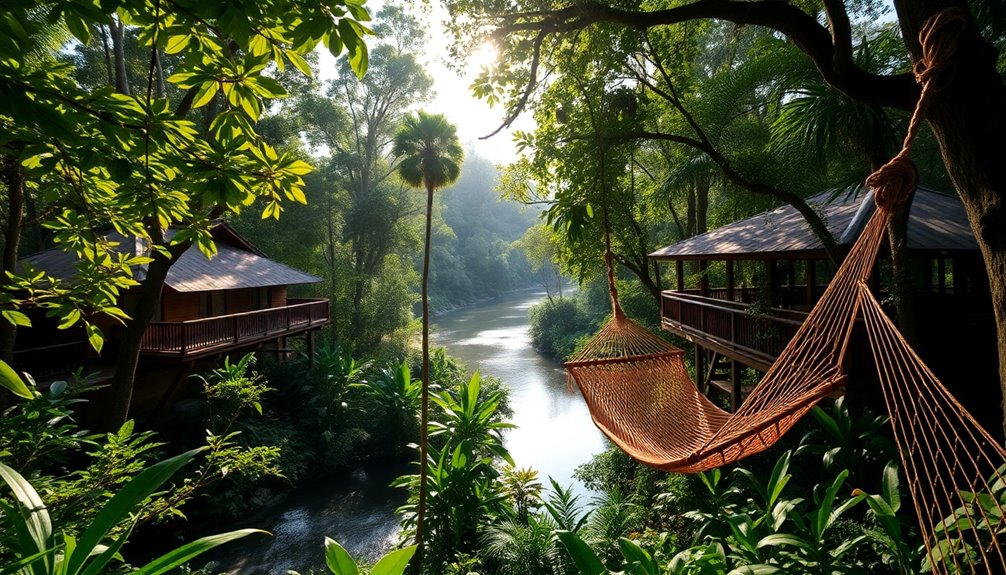
Supporting local eco-friendly businesses not only enriches your travel experience but also directly benefits the communities you visit.
By choosing places like Kapawi Eco-Lodge, you contribute 100% of the revenue to the Achuar Indigenous community, aiding in cultural preservation and sustainable development.
Eco-lodges such as La Selva and Sacha Lodge focus on reducing their carbon footprint, ensuring your visit leaves minimal impact on the Amazon rainforest.
Napo Wildlife Center collaborates with local communities, providing jobs and promoting traditional knowledge while emphasizing conservation.
Plus, many eco-friendly businesses use local ingredients in their cuisine, supporting farmers and enhancing your dining experience.
Community-led Reforestation Projects
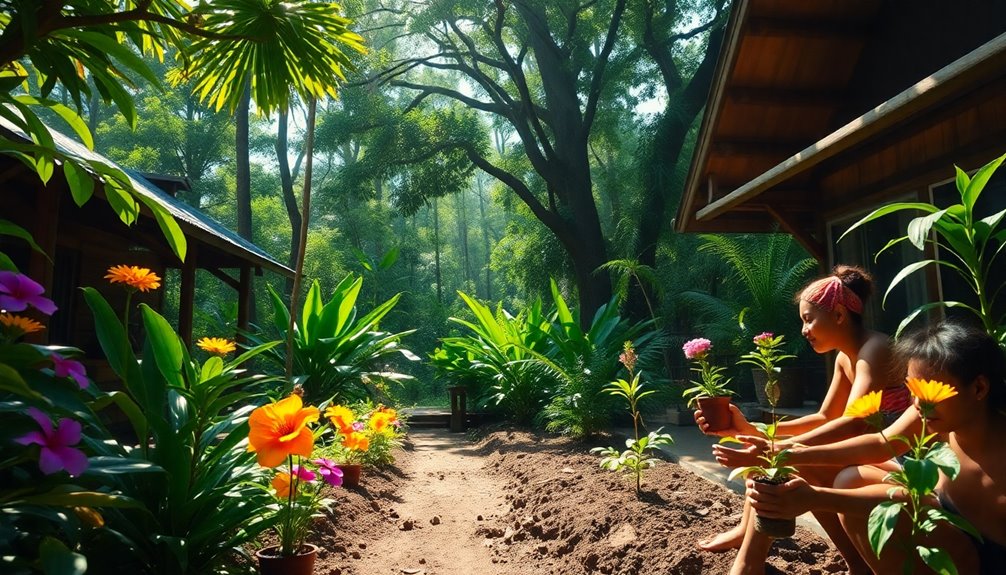
In Ecuador, community-led reforestation projects are essential for restoring ecosystems and supporting local cultures.
You'll find that these initiatives often involve partnerships between local communities, eco-lodges, and NGOs, all working together to enhance biodiversity and sustainability.
Government and NGO Efforts
As Ecuador grapples with the pressing issues of deforestation and climate change, government and NGO efforts shine a light on community-led reforestation projects.
These initiatives empower local indigenous communities to restore degraded lands and sustainably manage forest resources.
Here are three key aspects of these efforts:
- Planting Native Species: Programs focus on reintroducing native tree species, enhancing biodiversity and wildlife habitats.
- Collaborative Impact: Partnerships between NGOs and government agencies have led to millions of trees being planted, showcasing the power of local participation.
- Educational Outreach: Raising awareness about reforestation and sustainable practices ensures the long-term success of these community-led projects.
Together, these initiatives cultivate a greener future for both the Amazon and its indigenous communities.
Community and Cultural Sustainability
While community-led reforestation projects play a crucial role in preserving Ecuador's rich biodiversity, they also foster cultural sustainability among local indigenous groups.
By engaging the Achuar community and others in these efforts, you help ensure that 100% of ecotourism revenue directly supports their sustainable development and cultural preservation.
This community engagement not only restores degraded ecosystems but also enhances habitats for over 600 bird species and rare wildlife like jaguars and tapirs.
Educational programs accompanying reforestation initiatives raise awareness about rainforest conservation, encouraging both locals and visitors to participate actively.
Together, these projects promote ecological balance and combat deforestation, creating a brighter future for both the environment and the indigenous cultures that call the Amazon home.
Optimal Months for Eco-Travel
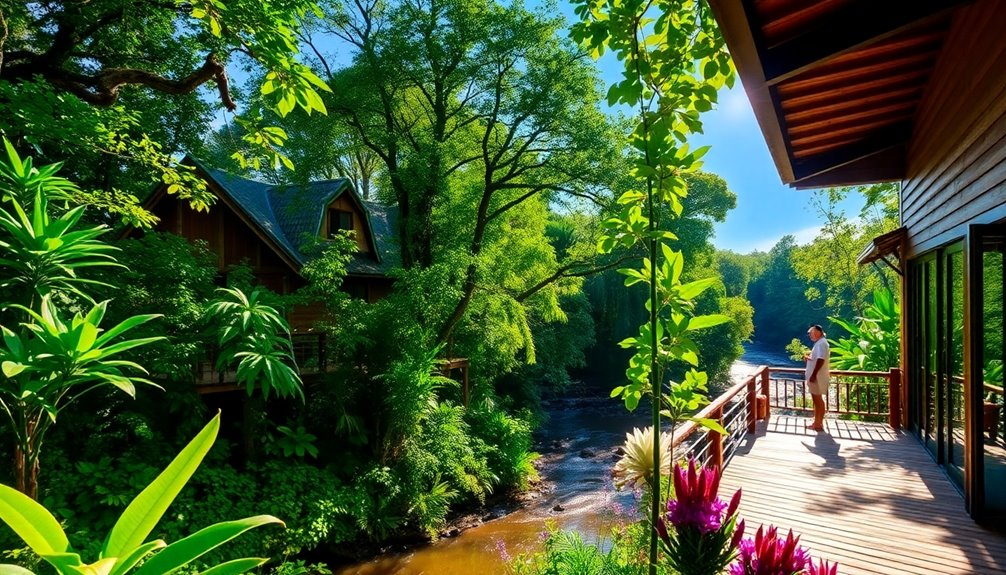
When planning your eco-travel in Ecuador, timing can significantly impact your wildlife viewing experience.
The rainy season, from December to May, draws animals to flooded areas, enhancing your chances of spotting unique species.
Conversely, if you prefer fewer mosquitoes and better hiking conditions, consider visiting during the low-water season from June to November.
Best Months for Wildlife Viewing
If you're planning a trip to Ecuador for wildlife viewing, timing can make all the difference in your experience.
The best months to visit are from June to November, during the low-water season, when the Amazon river recedes, making animals easier to spot.
Here's what you can expect:
- Enhanced visibility for wildlife, including monkeys and birds, as they gather near the riverbanks.
- Access to prime birdwatching locations, with over 600 species thriving during these months.
- Tailored wildlife viewing tours offered by many eco-lodges, maximizing your chances of spotting diverse rainforest fauna.
Rainy Season Impacts Wildlife Activity
Experiencing Ecuador's wildlife during the rainy season, from December to May, can be just as rewarding as the dry months. The increased water levels in the Amazonian waterways enhance navigability for eco-tours, allowing you to explore remote areas.
During this time, wildlife activity peaks as animals actively search for food and mates, making it a prime opportunity for observation. The lush vegetation provides abundant food and shelter, supporting vibrant ecosystems and over 600 bird species.
While heavy downpours are common, they create a unique rainforest atmosphere filled with rich sounds and sights. Plus, with lower tourist traffic, you'll enjoy a more intimate experience with nature and wildlife encounters that few others will share.
How to Make Your Trip More Sustainable
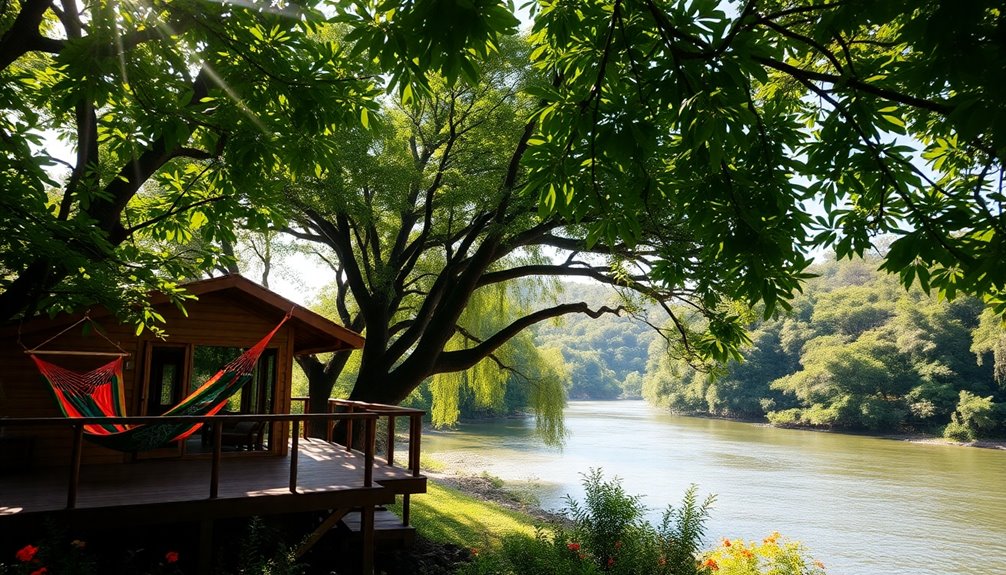
When planning your eco-friendly trip, consider using biodegradable toiletries and supplies to minimize your environmental impact. Supporting local artisans not only enriches your experience but also helps sustain the community's economy. Additionally, exploring eco-friendly excursions can promote responsible tourism practices while you enjoy the natural beauty around you. Together, these choices can make your visit more sustainable and meaningful.
Biodegradable Toiletries and Supplies
Sustainable travel in Ecuador's eco-lodges starts with the choice of toiletries and supplies. By opting for biodegradable toiletries, you help minimize environmental impact and protect the fragile Amazon ecosystem.
Many eco-lodges advocate for eco-friendly products that align with their conservation efforts. Here are three essential items to consider for your trip:
- Biodegradable shampoo and soap – They break down naturally, reducing pollution.
- Biodegradable wet wipes and toilet paper – These ensure waste decomposes without harming nature.
- Reusable containers – Bring your lotions and sunscreens in these to cut down on single-use plastics.
Choosing biodegradable supplies not only supports local communities but also fosters responsible tourism, allowing you to enjoy the beauty of the rainforest while protecting it.
Support Local Artisans
Supporting local artisans during your trip not only enriches your experience but also plays a vital role in sustaining the communities you visit. By purchasing handmade crafts and souvenirs, you ensure that traditional cultural practices are preserved. Many eco-lodges, like Kapawi Eco-Lodge, connect guests with artisans, fostering authentic exchanges. Engaging in workshops lets you learn traditional crafting techniques while contributing to the local economy. Additionally, staying informed about personal debt forgiveness options can help you manage your finances while supporting local economies.
| Artisan Craft | Description | Eco-Lodge Connection |
|---|---|---|
| Handwoven Baskets | Made from local materials | Workshops available |
| Traditional Jewelry | Crafted using age-old techniques | Sourced directly from artisans |
| Wooden Sculptures | Reflecting Amazonian culture | Exhibited in eco-lodges |
| Textiles | Vibrant designs and patterns | Available for purchase |
| Herbal Remedies | Natural ingredients | Offered in workshops |
Frequently Asked Questions
In Which Brazilian City Located in the Heart of the Amazon Rainforest Can We Find the Amazon Theatre?
You can find the Amazon Theatre in Manaus, Brazil, right in the heart of the Amazon Rainforest.
This stunning landmark, completed in 1896, showcases a beautiful neoclassical design topped with a colorful dome representing the Brazilian flag.
With a seating capacity of around 700, it hosts a variety of performances, from operas to classical concerts, making it a vibrant hub for culture and tourism in the region.
What Is the Ecuador Rainforest Famous For?
The Ecuador rainforest is a living tapestry, woven with vibrant threads of biodiversity and culture.
You'll discover a treasure trove of wildlife, from the majestic harpy eagle to playful monkeys. This lush paradise boasts over 16,000 plant species, creating a rich habitat for countless creatures.
It's also home to indigenous communities like the Achuar, who rely on ecotourism to preserve their cultures.
You'll find that every corner of this rainforest tells a unique story.
Is the Amazon Rainforest Called the Heart of the World?
Yes, the Amazon Rainforest is often called the "Heart of the World" due to its incredible biodiversity and crucial role in maintaining the planet's climate.
It houses about 10% of all known species and generates around 20% of the world's oxygen. By absorbing carbon dioxide, it helps regulate global temperatures, making it essential for life on Earth.
You can't underestimate its importance to both the environment and the millions of people who rely on it.
When Did Oil Exploration Begin in the Ecuadorian Amazon?
Oil exploration in the Ecuadorian Amazon began in the 1960s.
You might find it intriguing that the first exploratory wells were drilled during that decade.
By 1972, significant oil extraction activities kicked off in the Cuyabeno Wildlife Reserve, marking a turning point for the region.
As the government opened more areas for exploration in the late 1970s, environmental concerns grew, leading to protests and legal battles advocating for the Amazon's protection.
Conclusion
In the heart of Ecuador's Amazon, your adventure awaits, wrapped in nature's embrace. By choosing eco-lodges, you're not just indulging in a unique getaway; you're gently treading on a path toward a greener future. Every moment spent connecting with wildlife and supporting local communities is a step away from the ordinary. So, pack your bags, embark on this unforgettable journey, and let the lush landscapes whisper their secrets to you—it's time to discover a world where nature thrives.

